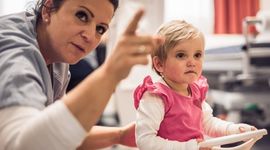Hospital - unplanned stay after a sudden illness
When a person with EB is admitted for an illness or an emergency to a hospital, where their history of EB is unknown, they need to inform the medical staff immediately. The staff has to be aware of the fact that EB patients have a higher risk for injury to their skin. When the staff is properly informed on admission you can avoid injury later.
Most important:
- The diagnosis and treatment of course depends on the current incident.
- The hospital personnel should be informed immediately of the vulnerability of the patients skin.
- Live saving measures take priority over protecting the vulnerable skin.
- An intubation (= placement of plastic tube for artificial respiration) for patients with severe forms of EB can be difficult. You should use a lot of gel on the smallest possible laryngoscope. Make sure the Endotracheal tube is fixed in place with „tracheal tapes“ made from gauze bandages. Avoid sticky surgical tapes whenever possible.
- Caution: When positioning the affected person you should always avoid a rubbing motion that causes friction to the surface of the skin! It is equally important to avoid these movements during positioning on tables for x-rays, CT scans and operating tables.
- Band-Aids and other sticky materials (i.e. ECG electrodes) should not be used! When removing the band aids or other glued materials the vulnerable skin often sticks. The fixation can be carried out with adherent, but non-adhesive material (i.e. Mepitac®, Mepilex®). In an emergency situation you will / can make an exception. It is essential to peel the used plaster (band aid) etc. very gently using the help of a "medical adhesive remover" (e.g. Niltac ®) or leave it alone and contact an EB specialist.
- The same is true for peripheral venous catheters ( I.V.), which can be necessary for infusions. The fixation can also be carried out with adherent, but non-adhesive material (e.g. Mepitac ®, Mepilex ®). If you can only fixate one bandage upon removal - of all other types of sticky type dressing bandages - proceed as described above.
- Blood draws and injections are possible, when preparing the skin for the procedure please clean the area with disinfectant spray or gentle application avoiding friction or rubbing of the skin. After removal of the needle do not use a band aid, use a fixating light pressure bandage.
- Diagnostic ultrasound tests can be done, yet friction to the skin from the head of the ultrasound sensor should be avoided as much as possible.
- When applying a tourniquet or blood pressure cuff to the patients arm, be careful not to injure the skin.
- When surgery is necessary it is important to have a patient on a soft operating table and careful positioning is needed to avoid pressure points. Surgical wounds usually heal well; you should try to set the suture a bit deeper in the subcutaneous layers as skin surface sutures to not hold well.
- The dressing technique for all wounds is the same - whether they are from an operation, an accident or just from EB itself.
- Dressing technique (initial and continuing care of open skin areas)
1. Gentle (!) cleaning and flushing (e.g. from contaminated wounds from an accident).
2. Direct contact wound dressing: no adhesive gauze (with or without Vaseline). When it is available you can also use Mepilex ® , a nice soft foam dressing suitable for EB skin.
3. Padding: with possibly tubular bandage or soft nonwoven gauze sponges
4. Fixation: with soft gauze or possibly tubular bandage - For the care of normal wounds for those affected with "regular" EB please follow these standardized methods!
- It is recommended that you should contact the EB Center where the patient is known, as soon as it is possible.

